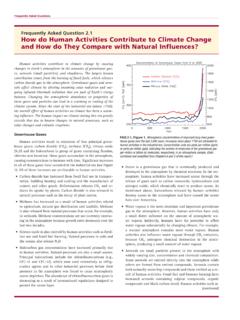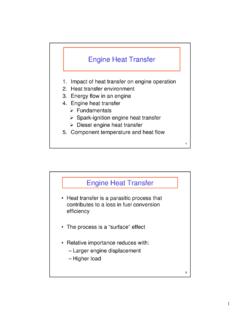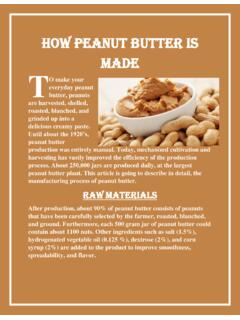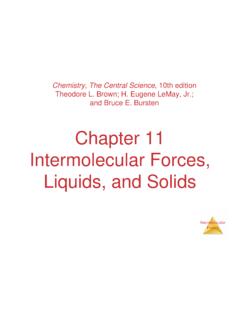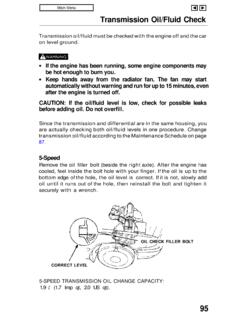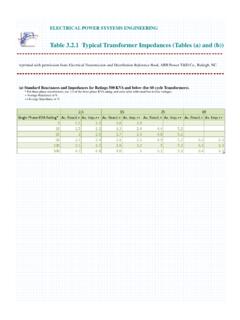Transcription of ELECTRICITY - A Secondary Energy Source - Lehigh University
1 ELECTRICITY - A Secondary Energy SourceA Secondary SourceThe Science of ElectricityHow ELECTRICITY is Generated/MadeThe Transformer - Moving ElectricityMeasuring Electricityenergy calculatorlinks pagerecent statisticsA Secondary SOURCEE lectricity is the flow of electrical power or charge. It is a Secondary Energy Source whichmeans that we get it from the conversion of other sources of Energy , like coal, natural gas,oil, nuclear power and other natural sources, which are called primary sources. The energysources we use to make ELECTRICITY can be renewable or non-renewable, but ELECTRICITY itselfis neither renewable or is a basic part of nature and it is one of our most widely used forms ofenergy.
2 Many cities and towns were built alongside waterfalls (a primary Source ofmechanical Energy ) that turned water wheels to perform work. Before electricitygeneration began over 100 years ago, houses were lit with kerosene lamps, food was cooledin iceboxes, and rooms were warmed by wood-burning or coal-burning stoves. Beginningwith Benjamin Franklin's experiment with a kite one stormy night in Philadelphia, theprinciples of ELECTRICITY gradually became understood. Thomas Edison helped changeeveryone's life -- he perfected his invention -- the electric light bulb. Prior to 1879, directcurrent (DC) ELECTRICITY had been used in arc lights for outdoor lighting.
3 In the late-1800s,Nikola Tesla pioneered the generation, transmission, and use of alternating current (AC) ELECTRICITY , which can be transmitted over much greater distances than direct 's inventions used ELECTRICITY to bring indoor lighting to our homes and to powerindustrial its great importance in our daily lives, most of us rarely stop to think what lifewould be like without ELECTRICITY . Yet like air and water, we tend to take ELECTRICITY forgranted. Everyday, we use ELECTRICITY to do many jobs for us -- from lighting andheating/cooling our homes, to powering our televisions and computers.
4 ELECTRICITY is acontrollable and convenient form of Energy used in the applications of heat, light andpower. THE SCIENCE OF ELECTRICITY developed by the National Energy Education Development ProjectIn order to understand how electric charge moves from one atom to another, we need toknow something about atoms. Everything in the universe is made of atoms every star,every tree, every animal. The human body is made of atoms. Air and water are, too. Atomsare the building blocks of the universe. Atoms are so small that millions of them would fiton the head of a are made of even smaller particles.
5 The center of an atom is called the nucleus. It ismade of particles called protons and neutrons. The protons and neutrons are very small,but electrons are much, much smaller. Electrons spin around the nucleus in shells a greatdistance from the nucleus. If the nucleus were the size of a tennis ball, the atom would bethe size of the Empire State Building. Atoms are mostly empty you could see an atom, it would look a little like atiny center of balls surrounded by giant invisiblebubbles (or shells). The electrons would be on thesurface of the bubbles, constantly spinning andmoving to stay as far away from each other as are held in their shells by an electrical protons and electrons of an atom are attracted toeach other.
6 They both carry an electrical charge. Anelectrical charge is a force within the particle. Protonshave a positive charge (+) and electrons have anegative charge (-). The positive charge of the protonsis equal to the negative charge of the electrons. Opposite charges attract each other. Whenan atom is in balance, it has an equal number of protons and electrons. The neutrons carryno charge and their number can number of protons in an atom determines the kindof atom, or element, it is. An element is a substance inwhich all of the atoms are identical (the Periodic Tableshows all the known elements).
7 Every atom ofhydrogen, for example, has one proton and oneelectron, with no neutrons. Every atom of carbon hassix protons, six electrons, and six neutrons. Thenumber of protons determines which element it usually remain a constant distance from thenucleus in precise shells. The shell closest to thenucleus can hold two electrons. The next shell can holdup to eight. The outer shells cans hold even atoms with many protons can have as many as seven shells with electrons in electrons in the shells closest to the nucleus have a strong force of attraction to theprotons. Sometimes, the electrons in the outermost shells do not.
8 These electrons can bepushed out of their orbits. Applying a force can make them move from one atom toanother. These moving electrons are ELECTRICITYE lectricity has been moving in the world forever. Lightning is a form of ELECTRICITY . It iselectrons moving from one cloud to another or jumping from a cloud to the ground. Haveyou ever felt a shock when you touched an object after walking across a carpet? A stream ofelectrons jumped to you from that object. This is called static you ever made your hair stand straight up by rubbing a balloon on it? If so, yourubbed some electrons off the balloon.
9 The electrons moved into your hair from theballoon. They tried to get far away from each other by moving to the ends of your pushed against each other and made your hair move they repelled each other. Justas opposite charges attract each other, like charges repel each AND ELECTRICITYThe spinning of the electrons around the nucleus of an atom creates a tiny magnetic objects are not magnetic because the atoms are arranged so that the electrons spin indifferent, random directions, and cancel out each are different; the molecules in magnets are arranged so that the electrons spin inthe same direction.
10 This arrangement of atoms creates two poles in a magnet, a North-seeking pole and a South-seeking MagnetA magnet is labeled with North (N) and South (S) poles. The magnetic force in a magnetflows from the North pole to the South pole. This creates a magnetic field around you ever held two magnets close to each other? They don t act like most objects. Ifyou try to push the South poles together, they repel each other. Two North poles also repeleach one magnet around and the North (N) and the South (S) poles are attracted to eachother. The magnets come together with a strong force.
